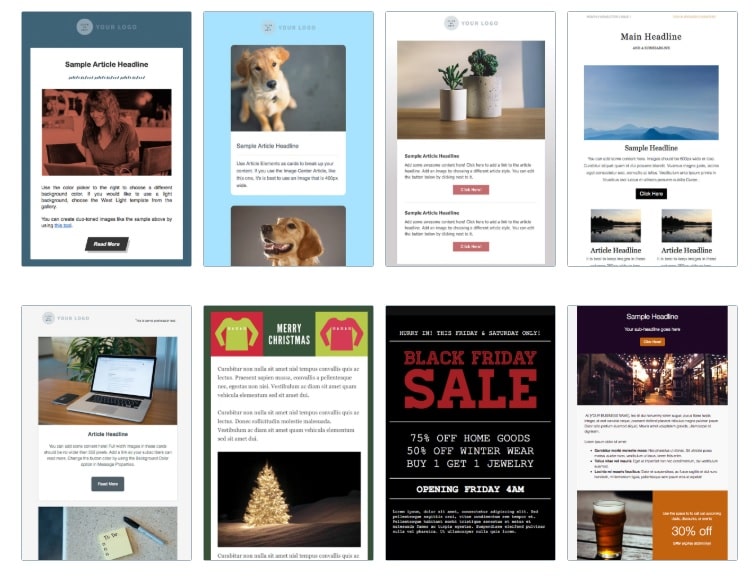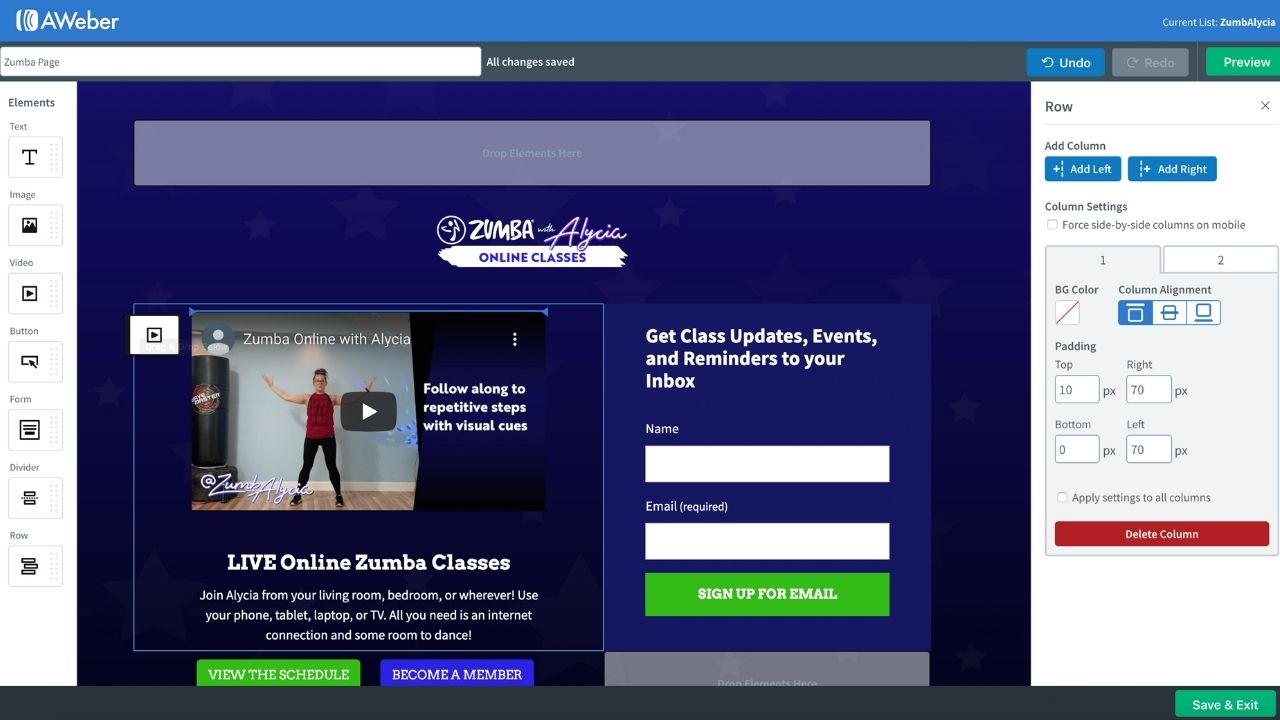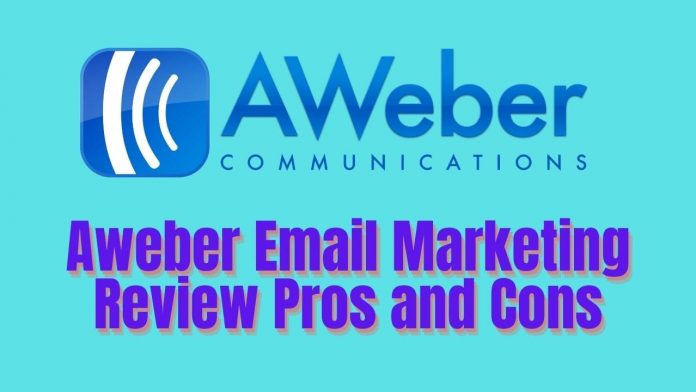In this Aweber Email Marketing Review Pros and Cons, I take an in-depth check out one of the most popular solutions for designing and sending HTML e-newsletters.
I’ll go through the pros & cons of Aweber email marketing and discuss its pricing, features, templates, interface, and more — by the end of this Aweber email marketing review, you’ll have a very clearer idea if it’s the proper email marketing tool for your business.
Let’s go!
Table of Contents
What is Aweber?
Aweber is an email marketing app that permits you to:
- Create the best mailing list and capture data onto it
- Design newsletters which will be sent to the subscribers on your list
- Automate your emails marketing via the use of ‘autoresponders’
- View and analyse statistics associated with your email marketing campaigns
Aweber was founded in 1998; and, According to the Aweber company, 100,000 individuals and businesses now use the platform for their email marketing.
Aweber pricing
There are two versions of Aweber: ‘Pro’ and ‘Free.’
For professional Pro plans, the pricing structure is as follows:
- Hosting & emailing a list containing up to 500 subscribers: $19 per month
- 501 to 2,500 subscribers: $29 per month
- 2,501 to 5,000 subscribers: $49 per month
- 5,001 to 10,000 subscribers: $69 per month
- 10,001 to 25,000 subscribers: $149 per month
If you have more then 25,000+ subscribers on your mailing list , you’ll need to call Aweber for a quotation.

Additionally, a completely free version of Aweber is available. This enables you to use most of the features of Aweber, so long as your email list is smaller than 500 subscribers (after this, you have to subscribe to a paid plan). You’ll access the free version of Aweber here.
Also Read: SEMRush Review
A 14% discount is available if you pay for quarterly; a 14.9% discount is available if you pay for annually. There also are some discounts available for college students and not-for-profit organizations.
One aspect of Aweber’s pricing Structure that potential users might like is that each one features are available on all plans — unlike some competing products, you do not need to be on more costly plans to unlock certain functionality. The differences in pricing are to do with e-mailing list size only.
That said, the functionality available on Aweber — as we’ll see below — not necessarily as extensive as you might find in competing email marketing solutions.
How does Aweber’s pricing compare to that of its competitors?
Aweber is, in general,
- Significantly cheaper than Campaign Monitor
- Considerably cheaper than iContact
- Roughly an equivalent price as Mailchimp
- Marginally more expensive than Getresponse
- Considerably more expensive than Mad Mimi
In some cases in fact we are comparing apples with oranges, however — these competing products have different feature sets on each plan, and subscriber limits which will occasionally make Aweber cheaper, occasionally more expensive.
But general, I’d say that Aweber is priced roughly within the middle of the e-mail marketing tool spectrum.
Of course, pricing isn’t the only factor you should base your decision on the more important thing to figure out is what bang you get for your buck.
So, let’s check out some Aweber features.
Key features of Aweber
Aweber provides you with the following key features:
- The ability to import & host a mailing list
- A wide range of templates
- Autoresponders
- Some (basic) marketing automation functionality
- Responsive email designs
- Reporting
- Split testing
- RSS / blog to email functionality
- List segmentation options
- A landing page builder
- Phone, email and live chat support
- Integrations with third-party apps
Let’s drill down into these.
Hosting your mailing list & importing data into Aweber
Importing an existing email database into Aweber is a pretty straightforward affair.
You can upload the subsequent file types:
- XLS
- XLSX
- TSV
- CSV
- TXT
Alternatively, you’ll add individual subscribers manually, or copy and paste rows of subscribers into the tool.
As you import your data, you’re given the choice to feature your subscribers to a specific set of autoresponders and tag them.
Not all competing products permit the addition of imported data directly into autoresponder cycles, so this is a pleasant feature to possess.
For anti-spam reasons, you’ll need to answer some questions on how you collected the info you’re importing.
And, if your list is on the larger side (over 10,000 records), you’ll even have to attend until it’s reviewed by Aweber’s anti-spam compliance team (as is that the case with other email marketing tools). This will take up to at least one business day.
In short, Aweber’s importing functionality is very nice no complaints here.
Also Read: Siteground Web Hosting Review
Templates
By comparison to its Competitors, Aweber provides one of the largest sets of HTML e-newsletter templates available: There are over 700 available.
To provide a touch of context, there are around 220 templates available for Getresponse, around 80 for Mailchimp and around 50 for Campaign Monitor.
Toe be honest, I don’t love all of the designs, But some of them look slightly dated. Mailchimp, Campaign Monitor & the new Getresponse templates are all a touch more contemporary in appearance.
However, the sheer volume of templates available means with a touch little bit of tweaking you ought to be ready to find an appropriate one for your e-newsletters. There is, of course, always the choice of coding your own template too.

Responsive email designs
Aweber’s email templates are all ‘responsive’.
This means that they automatically resize themselves to suit the device they’re being viewed on. During this day and age of smartphones & tablets, this is an important feature.
You can also see a preview of the mobile version of your email easily within Aweber, you only click a preview button and toggle a ‘mobile preview’ switch to see how your e-newsletter is probably to seem on a smartphone. (It’s still an honest idea to send some test emails, however, and check them on a mobile or tablet).
Using web fonts in Aweber templates
Unlike many other competing email marketing solutions, you’ll use web fonts in Aweber.
This is an honest thing because web fonts are usually more attractive than the quality ‘safe fonts’ (Times New Roman, Arial etc.) that email marketing apps often restrict you to; judiciously used, they will enhance the looks of an email considerably.
Additionally, counting on the typefaces you use on your website, they will also assist you to achieve more brand consistency between your site and e-newsletters.
Aweber currently allows you to use the subsequent fonts in your emails:
- Arvo
- Lato
- Lora
- Merriweather
- Merriweather sans
- Noticia Text
- Open Sans
- Playfair Display
- Roboto
- Source Sans Pro
- Permanent Marker
In general, it’s a thumbs up for Aweber’s templates, with extra brownie points awarded for the inclusion of web fonts. However, it might be good to see a couple of more fonts made available in Aweber, those included are a bit on the boring side.
RSS to email templates
Like similar e-marketing products, Aweber can take your site’s RSS feed and switch it in to e-newsletters that get sent out consistent with a schedule that you simply define. In Aweber, this is often called ‘Blog broadcasts‘, although technically you’ll use this feature with any content that has an RSS feed.
This functionality is especially handy for bloggers who want subscribers on their mailing lists to automatically receive e-newsletters containing their latest posts (or, indeed, a monthly digest of blog posts). In essence, it means you’ll power your newsletters from your website or blog, this will be a very big time-saver.
It’s worth noting that you simply can’t use the quality Aweber template designs for RSS-to-email purposes, however, you’ve got to choose on from a group of templates that are specifically designed for this purpose. (To be fair, Aweber isn’t alone during this)
On the plus side, there are quite a few of those to select on from quite most other e-marketing solutions I’ve tried.
On the downside, many of them don’t look great (they have a whiff of 1990s web design to them!).
And annoyingly, you can’t use the standard Aweber email drag & drop interface to edit them you need to make use of another editor (one which isn’t as user friendly).
With a touch of tweaking, you’ll likely be ready to find something that works ok, but i feel there’s definitely some room for improvement here.
Autoresponders
Autoresponders are a series of follow up e-mails that are automatically triggered by either time or user actions.
For example, you’ll create a program of autoresponders in order that
- When somebody signs up to your e-mailing list, they immediately receive a welcome message from your business.
- One week later they receive some offer or a discount code for a product
- Three weeks later they receive an encouragement to follow you on social media
Because they will really assist you save time and generate money, they’re usually a key a part of any e-marketing solution.
Aweber claims to possess invented autoresponders back in 1998 and accordingly, you’d expect their autoresponder functionality to be mind-blowingly good. Oddly, it’s just ‘okay’.
On the plus side, it’s very easy to line up follow up emails in Aweber supported interval — for instance, automatically sending subscribers an onboarding email immediately after check-in, a promo code 2 days later and a ‘follow us on social media’ email every week later is extremely easy. this is often a typical use of autoresponder — and it’s a breeze with Aweber.
On the downside, the choices available to trigger autoresponders supported user actions and purchases are much less extensive than you’d find in competing products.
Using Aweber, you’ll create ‘goals’ or combine automation rules with tagging to create autoresponders behave in reasonably sophisticated ways — but if you would like to make use of autoresponders in really advanced ways, you’ll likely get to check out other products, particularly Getresponse, which provides far more extensive ‘marketing automation’ functionality.
And speaking of marketing automation…
Marketing automation
Marketing automation is a feature That is increasingly offered by e-mail marketing solutions like Aweber.
I tend to consider it as ‘Autoresponders 2.0’ — where you go beyond traditional ‘drip’ campaigns and make complex user journeys using ‘IFTT’ (if this, then that) style workflows.
With marketing automation, you sometimes design a flowchart where emails are sent supported user actions: email opens, link clicks, site visits, purchases made then on.
Aweber recently introduced a replacement marketing automation feature which to a degree provides this functionality: ‘Aweber Campaigns.’
With this feature, you’ll use certain user actions — namely opens and clickthroughs — alongside the appliance of tags (which are often triggered if a user visits a specific page on your site) to work out what should be sent to whom and when (see above).
However, I feel this functionality need to go much further really – tools like Getresponse & Mailchimp provide considerably more flexibility when it involves which sorts of user behavior can trigger mailouts.
For example, in Getresponse, you’ll use triggers like purchase, specific page visits, subscriber ‘score’, and sales pipeline stage to send messages. Mailchimp works in a similar way.
So Aweber is certainly playing a touch of catch up with its competitors here.
Spotlight on… Aweber’s free plan
Perhaps during a bid to compete with Mailchimp, Aweber now offers a completely free plan. this is often relatively unusual within the email marketing world — most similar products offer a free trial, but not indefinite access to the merchandise.
Aweber’s free plan manages to be both less generous AND more generous than the Mailchimp plan. It’s more generous because, with the exception of a few features (notably split testing and abandoned cart emails), you get access to the majority of Aweber’s functionality free of charge. Mailchimp’s free plan restricts functionality to a couple of core features — you cannot use any automation thereon in the least, for instance.
Aweber is a smaller amount generous therein the free plan only works if your list is 500 contacts or less in size; Mailchimp’s free plan, against this, allows you to work with an inventory of up to 2000 subscribers.
Both products display adverts for his or her brand on e-newsletters sent with their free plans; it’s reasonably subtle, however.
You can try the free plan Aweber plan out here,
AMP for e-mail in Aweber
An area where Aweber has an edge over most other e-mail marketing platforms involves a replacement technology called AMP for e-mail.
Traditionally, e-newsletters are very static affairs — an easy combination of text and pictures. AMP for Email changes all that by making it possible for recipients to require simple actions (such as making a meeting or RSVP-ing to an event) directly within an email — i.e., without leaving their email program or visiting a blog or website.
It also allows the senders of an e-mail to insert dynamic content into it — for instance, live survey results, weather updates, football scores than on.
This ‘dynamic’ nature of AMP e-mails gives recipients a reason to return to them periodically — and turns e-newsletters into considerably more powerful, engaging pieces of content.
Check out the below video from Google for an introduction to the planet of AMP for e-mail.
Opt-in processes
A nice feature of Aweber is the flexibility it gives you around how you would like to handle the opt-in process.
You can prefer to subscribe to your Users on either one opt-in or a double opt-in basis (single opt-in is when a user is subscribed immediately after completing a form; double opt-in is once they need to click on a link during a confirmation e-mail to finish their subscription).
Both approaches have their merits, so it’s good to ascertain Aweber being flexible during this regard — not all competing solutions (examples including Zoho and Squarespace’s Email Campaigns) provide their customers with this choice.
Split Testing
Split testing (also referred to as A/B testing) involves sending variants of your e-newsletters to a number of your email marketing list, monitoring the performance of every, and sending the ‘best’ version to the rest of your email marketing list.
Most e-marketing tools handle this automatically for you: you create a couple of different versions of your email (using either differing content or subject headers), send them to a sample of your data, and your e-marketing solution will roll out the simplest performing version automatically to the remainder of your list.
With Aweber, you’ll send up to 3 variants of your e-newsletter when split testing. This compares reasonably well with other email marketing tools: Mad Mimi doesn’t facilitate split testing at all; Campaign Monitor only allows you to use two variants; and Mailchimp, like Aweber allows three.
Reporting
E-mail analytics in Aweber are good. Additionally, to having the ability to watch key stats like open rate, clickthroughs, and bounces, you’ll also check out tons of other useful analytics/information, including
- The growth of lists over time
- An overview of check-in methods
- Where people are opening your e-mail (i.e., geographical location)
- The history of an individual’s activity – you’ll view past opens and clicks, etc. At a per-subscriber level and much else besides.
In terms of how this compares with competing products, I might say that Aweber’s reporting is more comprehensive than that which is out there in Campaign Monitor or Mad Mimi; however, I might argue that Mailchimp and Getresponse both provide better reporting interfaces.
With the latter two products, you seem to be ready to get more of a summary of data in one place, particularly when watching the performance of individual e-newsletters.
By contrast, With Aweber, you’ve needed to flick between three sections — “Broadcasts”, “Subscribers” & “Reports” to get an overall picture of analytics, whereas Getresponse and Mailchimp present most of their reporting information on one dashboard (which you’ll then use to drill right down to specifics).
That said, Aweber is performing on a replacement, cleaner reporting interface at the instant — a BETA version is currently available. This remake is considerably easier to navigate and use.
Segmenting data in Aweber
Segmenting data in Aweber is pretty straightforward. you’ll create segments not only supported the contents of any field in your database but also on user activity too – emails opened, sites visited, links clicked, products bought then on. It’s all very flexible and straightforward to use.
It’s a bit tricky however to figure out the way to get to the screen where you create the segments — you basically need to attend a ‘manage subscribers’ section, look for some subscribers then save the search as a segment.
To be fair, some solutions (such as Getresponse) use an identical approach to segment creation — but others (such as Campaign Monitor and Mailchimp) provide a more obvious ‘segments’ section.
Unfortunately, Aweber doesn’t allow you to broadcast emails to multiple segments directly, however. This may cause problems for a few users who have a requirement to ‘pick and mix’ segments in mailouts on a daily basis.
For example, say you are a dealer with a list containing a field called ‘car model.’ You’ve used this field to segment your list into owners of VW Polos, Golfs, Passats, Tiguans, and Touregs.
You now have a suggestion which is specifically relevant to Polo, Golf and Passat owners, and you would like to send a message about it to those three segments in one go.
In a perfect world, you’d just be ready to select the relevant segments and send the message to those three groups. With Aweber though, this is not possible. You’d need to either send three individual messages or create a fresh segment targeting ‘Polo OR Golf OR Passat.’
You’ll have an identical problem if you would like to exclude certain segments from the broadcast; so ultimately it is a little bit of thumbs-down for the segmenting functionality in Aweber.
On the plus side, Aweber now allows you to send emails to multiple lists — something that’s prohibited by key competitor Mailchimp.
Ultimately however other email marketing tools, especially Getresponse and Campaign Monitor, handle segmentation in a far better way.
Landing Page Builder
Landing pages or ‘squeeze pages’ are sites that are designed with only one thing in mind: data capture. They typically usually contain a form, some attractive images, and a little amount of text spelling out the advantage of submitting your email address.
They typically capture data more effectively than forms placed on regular websites, just because there are less distractions available — no navigation offers or content to require attention faraway from a sign-up form is present.
The good news is that Aweber recently introduced landing pages as a replacement feature — you’ll now use the platform to style simple landing pages which may be utilized in conjunction with advertising campaigns.

On the plus side, the landing page builder is extremely straightforward to use, and you’ll make use of some free stock photos when designing your page. you’ll also add a Facebook Pixel and Google Analytics tracking code to your pages, which is useful when trying to assess the performance of advertising campaigns.
On the negative side, there’s no A/B testing. One of the key advantages of employing a landing page builder is that the ability to run real-time tests of various landing pages, to ascertain which version performs best.
And, although the power to feature Facebook and Google Analytics tracking code to proceedings is beneficial, it doesn’t seem as if there’s how to form this GDPR compliant — if you employ these cookies, you would like a mechanism which allows EU visitors to stop them being run, and there doesn’t appear to be how to facilitate that yet with this tool.
Overall, a thumbs up for this feature’s inclusion, but it definitely needs improvements.
Integrations with third-party apps
Aweber Offers an honest range of integrations with other solutions. There are about several hundred integrations available which permit you to attach Aweber to varied sorts of cloud-based software — web builders like Wix or WordPress; CRM tools like Salesforce; landing pages like Instapage then on.
Some of these involve dedicated widgets; others involve adding a snippet of code into a website; others involve a sync tool like Zapier or Pie Sync.
It’s rare that Aweber will plug into other software quite as seamlessly as Mailchimp (which seems to be the default ‘standard’ email marketing option for tons of apps), but you should not have an excessive amount of difficulty getting Aweber to figure with an honest range of other SaaS (software as a service) apps.

Aweber support
Aweber’s support is one of the stand-out features of the product.
Phone support, email support & live chat support is all available — this compares very favorably with some key competitors including Getresponse, Mailchimp, Campaign Monitor, and Mad Mimi, none of which offers phone support.
Additionally, there are no hoops to travel through to contact support: relevant telephone number and email details are often viewed very easily on the company’s contact page, with none requirement to trawl ‘knowledge bases’ or fill in any forms beforehand.
On top of that, the corporate has won several Stevie Awards for customer services over the past few years, which augurs pretty much for the standard of the support you’ll receive once you contact them.
If you’re a novice to email marketing, then this type of quick access to good-quality support may be a strong argument in favor of using Aweber as your email marketing provider.
In terms of the supply of support, you’ll contact Aweber’s phone support team from 8am-8pm ET Monday to Friday, and their email and live/chat support is out there 24/7.
Aweber Email Marketing Review Pros and Cons
Overall I would say Aweber is one of the best and solid email marketing tool. It isn’t absolutely the best product of its kind available, but it’s reliable, affordable, easy to use and contains most of the key features you’d expect from an email marketing solution.
The main aspects of the merchandise that might nudge me in Aweber’s direction are its ease-of-use, web fonts, landing page builder, AMP for email functionality and comprehensive support. Its free plan is generous too, giving users with small lists access to all or any the key features indefinitely.
The support aspect could also be particularly important for users who are starting call at e-marketing without many technical skills (because problems, should they arise, are often addressed by lecture a true person on a true phone line!).
Additionally, Aweber isn’t too expensive in comparison to some competing products, especially Campaign Monitor and iContact.
The main things that might dissuade me from using Aweber are its relatively basic automation features and therefore the way you can’t broadcast to multiple segments of knowledge directly.
I hope you’ve found this Aweber review Helpful so far, but if you haven’t made your mind up on whether this is often the e-marketing solution for you, below you’ll find an easy breakdown of the key pros and cons of using it.
Pros and cons of Aweber
Pros of using Aweber
- An entirely free plan is out Available.
- It’s very easy to use.
- It comes with a really large range of templates — considerably quite its key competitors.
- Support options are more extensive than is that the case with some key competing products and supported Aweber’s Stevie awards for customer service, should be high.
- It’s affordable — whilst not the most cost-effective product of its kind out there, it’s cheaper than several similar solutions.
- It has a built-in landing page builder.
- It facilitates AMP for email — something of a primary for email marketing tools.
- It allows you to choose whether to let people subscribe to your email mailing list on one or double opt-in basis.
- It has good import functionality, with the choice to import a good range of file types and add the e-mail addresses you’re importing on to an autoresponder cycle.
- It integrates with an honest range of third party tools and apps.
- It makes fixing up simple time-based autoresponders very easy to try to to.
- All email templates are responsive.
- You can use web fonts in e-newsletters sent with Aweber.
AWEBER FREE PLAN
Cons of using Aweber
- You can’t include or exclude multiple segments directly when sending an e-newsletter.
- There are cheaper options out there that supply considerably more features within the marketing automation department.
- While the landing page builder is beneficial, it doesn’t provide A/B testing or how to use Facebook pixels / Google Analytics cookies during a GDPR compliant way.
- Some of the templates look a touch dated.
- The RSS to email templates are poor and that they can’t be edited using Aweber’s standard drag-and-drop email builder.
Alternatives to Aweber
There are many alternatives to Aweber available.
If you’re trying to find something a bit more feature-packed at an identical price point, Getresponse is that the obvious contender. Additionally to allowing you to perform the type of email marketing tasks that Aweber facilitates, it also provides webinar functionality and e-commerce features.
Mailchimp is additionally a far better-specced tool, but with the recent changes to its pricing structure, it doesn’t always offer great value for money.
Another product worth considering is Hubspot — this is often a CRM product, but it also features some very nice email marketing features.
If you’re trying to find something cheaper, then Mad Mimi is worth investigating (but bear in mind that Mad Mimi may be a far more basic solution than Aweber).
If you’ve tons of money then Campaign Monitor is worth a glance too — it’s got a lot of nice features but it’s extremely expensive by comparison to all or any of the aforementioned products.
Any thoughts on Aweber?
If you’re an Aweber user or thinking about becoming one, we’d like to hear from you — scroll right down to add your thoughts or queries on the product within the comments section below! And be happy to share this post if you found it helpful.











